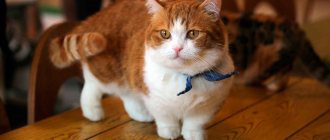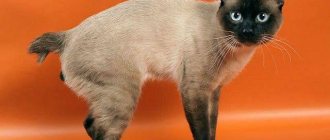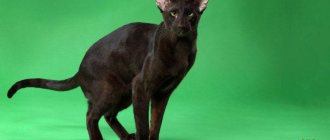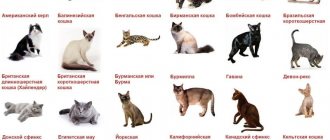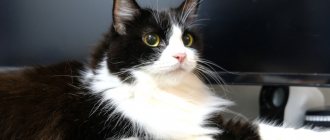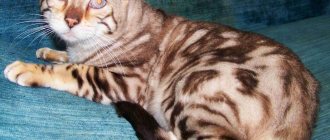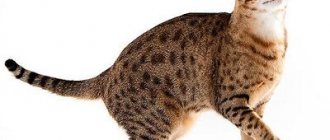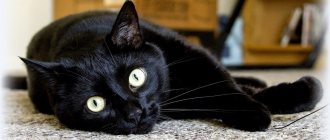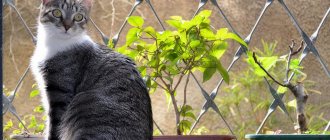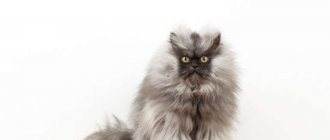This breed cannot be confused with any other. An elongated, tightly knit body with the flexibility of a ferret and short legs are the distinctive features of munchkins. The cat-like dachshund, plush and playful, is a favorite of many families. The popularity of the breed is increasing every year, developing the fashion for funny, clumsy and cute cats. Home videos and photos of these babies are flying around the web and getting a lot of approval. Munchkins are valued for their gentle nature and exotic appearance. Briefly the breed can be described as follows:
- playful;
- friendly;
- quiet;
- average build;
- not demanding in care;
- not hypoallergenic;
- well adapted to apartment life;
- gets along with children.
Owners note their intelligence, quick wit and easy-going nature. They are becoming popular in all countries, especially in the East because of their cute appearance. These exotics are friendly, sociable and easy to keep. They become wonderful companions and full members of the family.
Origin story
Until the end of the 80s. Most experts believed that the short-legged animal was inferior and unhealthy. The Munchkin, as an independent variety, began to develop in 1983.
In Louisiana, Sandra Hochenedel picked up a street cat with abnormally short legs. The woman believed that this feature was related to her lifestyle: she ate poorly and could not develop normally.
However, the cat gave birth to kittens with the same short legs. The owner was very surprised and gave one female from the litter to her friend. After a while, she also gave birth to short-legged babies. Sandra thought about this amazing phenomenon and turned to a veterinarian.
Studies were carried out, after which the veterinarian concluded that the peculiarity of the structure of the animal’s legs was due to a mutation in the genetic code. It was found that this is not a defect and does not affect health.
The description of the Munchkin breed was compiled two years after the appearance of the first offspring. Many breeders continued to consider the animals inferior and ugly. However, in 1995 they began to be presented at exhibitions.
Dependence of price on class
1. Show class. These are cats that best meet the standard of external characteristics and have an outstanding pedigree. Animals are distinguished by excellent health, stable psyche, and do not have developmental disabilities.
Show class kittens are not neutered; they are the standard of the breed and are allowed for breeding.
The elite class includes munchkins with the shortest legs. Show-class cats cost from 80,000 to 200,000 rubles.
2. Breeding class. The kittens also meet the standard, are healthy, can participate in exhibitions, and are allowed for breeding. But they have some disadvantages that do not allow them to be classified as the highest class.
The average cost of a kitten is 20,000 – 80,000 rubles.
3. Pet class. The cheapest animals. Such kittens do not have documents and have significant defects in appearance. Cats are not allowed for exhibitions or breeding.
Pet-class kittens cost from 2,000 to 15,000 rubles.
Little munchkin kitten/Yandex Collections
Separately, munchkin hybrids can be distinguished. Cats are crossed with representatives of other breeds.
The result is short-legged cats with the external characteristics of a certain breed. There are many munchkin hybrids, they all have their own names.
In general, they are called by a common word - dwarves (gnomes).
You can only find out how much such a cat costs from private breeders.
Hybrids are considered illegally bred, are not sold in nurseries and are much cheaper than purebred munchkins.
Distinctive features
The breed appeared relatively recently, so its standard has not yet been fully formed. However, the basic characteristics are already there:
| Sign | Description |
| Head | Wide, with smooth outlines, wedge-shaped. Proportional to the body. In adult males it is more developed than in females. |
| Nose | Average, slight bend allowed. |
| Ears | Located high. Fluffy, wide at the base, rounded at the tips. |
| Eyes | They have the shape of a walnut. Located widely, at a slight angle to the ears. The shade depends on the color of the coat. |
| Neck | Thickened and muscular, of medium length. |
| Torso | Medium size. |
| Paws | The hind ones are slightly longer than the front ones. It is permissible to bend the latter towards the inside. Limbs are straight. |
| Backbone | Not heavy, but not lightweight. |
| Muscles | Well developed. |
| Tail | Equal to the length of the body. Stands upright when moving. |
| Weight | In males - 3-4 kg. In females - 2-3.6 kg. |
| Wool | Short: shiny, plush to the touch. Long: dense and silky with a lordly collar. |
| Coloring | Any colors and combinations. |
Interesting Facts
Munchkins are such an unusual breed that a lot of interesting things can be said about them. Here are a few facts worth noting:
- In our country during the existence of the USSR in the 50s. There was a similar breed of cat with short legs called the Stalingrad kangaroo. Biologists explained the appearance of this feature in cats by post-war difficulties. Soon these felines completely disappeared.
- Munchkins have one unique habit - standing on their hind legs. Periodically, they freeze in a vertical position, while holding their tail with their front paws. This may last 10 minutes or more. This is how the cat surveys the surroundings.
- Experts do not recommend knitting them together. Such a partnership leads to the birth of defective babies. The best option is when the male has a standard appearance and the female has short legs.
- Munchkinis are officially listed as the shortest cats. Thus, the American purr named Lily is listed in the Guinness Book of Records. Her height is 13.5 cm from the bottom.
- Their legs are divided into categories, depending on the length: classic - up to 20 cm, medium - up to 15 cm and shortened - no more than 13 cm. The latter option is extremely rare.
- Munchkins are often compared to magpies. This is due to their penchant for stealing everything that glitters. They store found objects in hidden places so they can play with them alone.
Graceful gait
With good living conditions and proper care, these animals can easily live up to 13 years. This is significantly less than the period allotted to classic cats. Veterinarians suggest that the reason is short legs, which leads to poor health with age.
Nutrition
The number of meals depends on the age of the pet:
- up to four weeks - five times a day;
- from twelve weeks to one year - three or four times;
- adults - twice.
Up to four months it is necessary to give porridge, meat, and fermented milk products. The diet of adults includes vegetables and fish fillets.
Premium dry and wet food and holistic foods are recommended.
Required products on the menu:
- unsweetened fermented milk products without dyes and synthetic thickeners;
- dietary meat;
- sea fish;
- cereals, excluding legumes;
- vegetables, except potatoes;
- chicken and quail yolks;
- meat by-products (for example, liver).
Fish and meat should be boiled and mixed into porridge. Vegetables are not fully digestible by animals. This must be taken into account when creating a menu.
Hygiene
Munchkins come in long-haired and short-haired varieties. Pets should be combed with a slicker brush, comb, or brush. The movement is from head to tail. Done once a week.
Wash cats if necessary. A special shampoo is used, selected according to the type of coat and skin. After bathing, the pet is dried with a soft cloth or dried with a hairdryer.
Munchkin's eyes are treated with a cotton pad soaked in boiled water or tea. Teeth are brushed every two weeks with cat toothpaste. Wax and accumulations of dirt from the ears are removed with cotton swabs with a special solution or drops, Vaseline. The claws are trimmed as they grow with a nail clipper.
Breeding
Breeding Munchkins should be done by professionals.
Anyone who intends to breed Munchkins must understand one thing - the gene for “short limbs” is inherited from one of the parents. If both partners are short-legged, then one hundred percent of the litter will contain dead kittens or freaks. Therefore, one of the pair must have normal paw length. This is the main reason why breeding is best done by professional breeders.
In addition to the fact that it is unacceptable to bring two Munchkins together, lop-eared and short-tailed representatives are not taken into a pair. Then the result is a small number and low-quality offspring due to the burden of additional mutagens.
Sexual maturity is reached by one and a half years. Males can be allowed to breed up to 4 times a year, but for cats it is contraindicated for health reasons to give birth more than 2 times a year. In other respects, breeding is the same as for other cats.
Health
Munchkins are hardy and healthy. They have a strong immune system and no predisposition to severe genetic pathologies.
A hereditary disease to which the breed is susceptible is lordosis of the spine in the form of its stretching in the thoracic region.
The pathological condition provokes problems with the heart and lungs. Most often, the disease manifests itself in obesity or genetic characteristics. Therefore, it is important to monitor your pet’s diet and carefully choose a partner when mating.
Breed faults:
- convex chest;
- too round head and eyes;
- absence of tail, fingers, polydactyly;
- snub or elongated nose;
- “cow set”;
- short, very stocky body;
- curly hair;
- concave back, drooping croup;
- absence of testes;
- blindness and strabismus.
Also, a cat will be disqualified at an exhibition if it has a difficult character, cowardice, or aggressiveness.
Munchkin colors
They do not have an unconditional list of colors. The standard does not prohibit different colors. This is due to the natural origin of animals, and not through artificial breeding.
At exhibitions you can see such cats of various colors:
- rich red;
- gray;
- white;
- chocolate;
- marble;
- black.
Unusual color of the breed
A combination of several colors, as well as the presence of spots and stripes, is allowed.
Since the breed is still experimental, it is allowed to breed cats of any color. But there are plans to develop uniform color requirements by 2025.
Advantages and disadvantages
The breed has many more positive aspects than negative aspects:
| Advantages | Flaws |
| Obedient, good-natured, smart. | They have a habit of hiding things. |
| They calmly accept changes and new surroundings. | They don't catch rodents. |
| They rarely get sick. | You should not be allowed out for walks unattended. |
| They don’t jump on tables or cabinets, so they don’t hit fragile things or steal food. | If you don't hide the toys, they wake you up at night. |
| Do not require special care. | |
| Not picky eaters. | |
| Do not spoil indoor flowers. | |
| They are good with children and other pets. | |
| Not intrusive. | |
| Not aggressive. | |
| They rarely meow. |
Breed behavior
The dachshund-like cat is calm, intelligent and sociable. They learn commands and are happy to bring objects and fulfill other wishes of the owner. They will willingly take part in the game if it is not too active and long.
This is not a loud breed. Owners note that they have not heard any sounds from their pets for years. A cat with short legs can start meowing only in an emergency or very emotional situation (danger, meeting after a long separation from the owner, illness).
Munchkins are very thrifty cats, in other words, they have developed “magpie syndrome”. They often steal their owners' things and drag them into their house or secluded corners. This habit is very disciplined - if you don’t want to look for property under the sofas and behind the cabinets, it’s better to immediately put them in their place.
It is better to arrange beds for them on the middle level, level with the sofa, on an armchair, near the radiator. On the ground, the cat will not be comfortable and restless, and it will not be convenient to climb too high.
Price
When deciding to buy a kitten, you need to pay attention to the following:
- age of parents;
- number of matings between father and mother;
- diseases of parents, hereditary pathologies;
- features of pregnancy and childbirth;
- absence of individuals with extra toes in the litter;
- availability of certificates of vaccinations and deworming in accordance with age;
- sterilization and castration;
- behavioral characteristics of the kitten and its parents;
- food given to the animal;
- content rules.
A kitten without documents costs between 15-25 thousand rubles.
Purebred individuals - 40-60 thousand rubles. The price of animals in high-level nurseries is determined by experts. Lilieput – Shortest Cat Guinness World Records 2014 Photo Credit: James Ellerker/Guinness World Records 1111
Genetics of Munchkin birth
The exact reason for the Munchkin's short legs has not yet been established. This mutation occurred spontaneously and did not affect other organs of the animal. Of course, breeders do not deliberately inhibit the growth of limbs with the help of special medications and other methods.
The gene responsible for this feature is selectively inherited by cats. So a litter can have kittens with both short and long legs. Work on studying the unknown gene is still underway. American scientists are especially active in this. They published the results of their many years of effort in the BioRxiv electronic repository.
